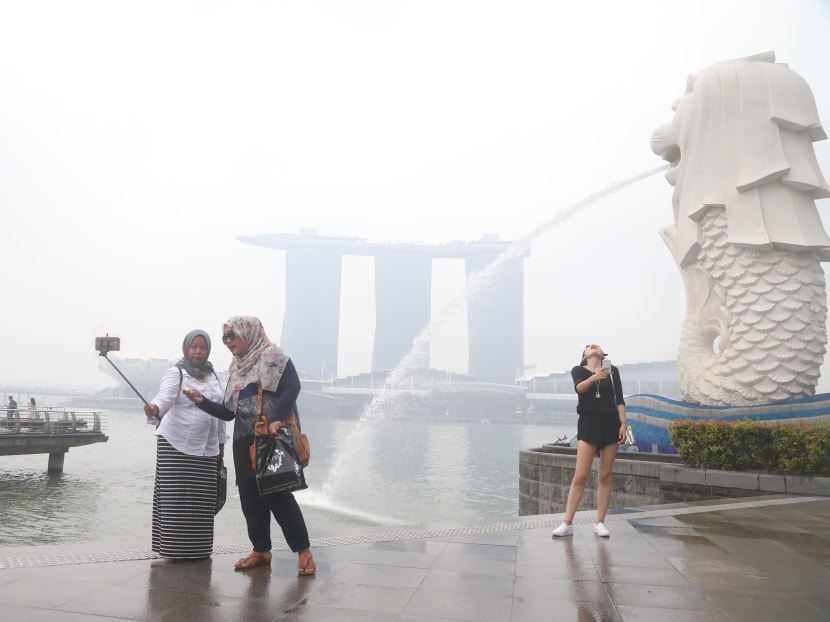New PM2.5 bandings to help people plan activities better
SINGAPORE — One-hour readings of the fine particulate matter concentration (PM2.5) in the air now come with bands indicating if levels are normal, elevated, high or very high, to help the public to interpret one-hour PM2.5 better, and to plan their immediate activities.
SINGAPORE — One-hour readings of the fine particulate matter concentration (PM2.5) in the air now come with bands indicating if levels are normal, elevated, high or very high, to help the public to interpret one-hour PM2.5 better, and to plan their immediate activities.
Under the new banding, one-hour PM2.5 concentrations of 55 micrograms per cubic metre and below are “normal”; readings of 56 to 150 are “elevated”; readings of 151 to 250 are “high”; and anything above 250 is “very high”.
But the one-hour readings are not tied to health advisories, which apply only to 24-hour Pollutant Standards Index (PSI) readings because studies on sub-daily PM2.5 exposure still do not provide a sufficient evidence base, said the National Environment Agency (NEA), which introduced the banding on Monday (June 27).
The 24-hour PSI forecast will also continue to be used for major decisions such as the closure of schools.
Instead, the one-hour PM2.5 readings now come with a general guide noting that each person’s reaction to pollutants may vary. Hence, the level of physical activity should be according to one’s health status.
Although the PSI includes other pollutants like sulphur dioxide and carbon monoxide, PM2.5 is the air pollutant of concern during haze episodes, because their small size mean they can lodge deeply in the lungs.
The highest one-hour PM2.5 recorded in Singapore last year was 471 on Oct 19, when the region was affected by forest and plantation fires raging in Indonesia.
Last year, Singapore’s one-hour PM2.5 readings fell within the “normal” band 88.9 per cent of the time during both haze and non-haze periods. During the haze period, readings were still mostly within the “normal” range (49.6 per cent), followed by the “elevated” (41.6 per cent), “high” (7 per cent), and “very high” (1.8 per cent) bands.
With the introduction of bands for one-hour PM2.5, the NEA will do away with three-hour PSI readings as they will “no longer be relevant”, by the end of the year.
Speaking to reporters about the new banding during a visit to the Meteorological Service Singapore headquarters on Monday, Environment and Water Resources Minister Masagos Zulkifli said: “We want to position this more as an advisory band, rather than something which is medically impacting them.”
On how institutions, such as schools and military camps, should interpret the PM2.5 readings, Mr Masagos said they would still use the 24-hour PSI forecast, and whether they decide to continue with activities based on the one-hour PM2.5 readings would be left to their discretion.
The Ministry of Education said one-hour PM2.5 readings would be used as “an indicative measure to make the necessary adjustments” for more immediate activities. Activities for the next day would be planned using the NEA’s 24-hour PSI forecast and the corresponding MOH health advisory.
The Ministry of Defence (Mindef) said that apart from guidelines for the conduct of training in haze conditions, which use the 24-hour PSI, its commanders on the ground conduct a risk assessment before each outdoor or training activity, taking into account factors such as weather.
Commanders, Mindef said, could use the new PM2.5 bands as “one of the factors when making their risk assessments”.
The Ministry of Manpower (MOM) noted there is “insufficient evidence base” to develop workplace safety and health advisories for the one-hour PM2.5 readings. The readings, the MOM added, could also fluctuate over the course of a day.
Dr Madeleine Chew, a family physician at MW Medical Centre, said at the “elevated” band, patients with respiratory disorders, heart disease and lung cancer should avoid outdoor activities, while healthy adults should reduce their participation in such activities. The “high and “very high” bands should see only indoor activities, she said.
Killiney Family and Wellness Clinic’s Dr Clarence Yeo said the hourly readings would be “quite useful” as they provide more up-to-date information. But in advising patients, he would still use it “more as a guide (such as) whether you should go out and do a run.”
Meanwhile, a workplace safety and health coordinator in a construction firm, who wanted to be known only as Mr Khoo, said he was unlikely to refer to the bandings as they are only guidelines, adding the air quality here is generally good.
Associate Professor Matthias Roth, deputy head of the National University of Singapore’s geography department, noted that in cleaner cities, what would be considered “normal” here could be considered high elsewhere, such a city with less emissions from industries and vehicular traffic.
Also, readings in the “normal” range do not necessarily mean there are no health effects, he added.









